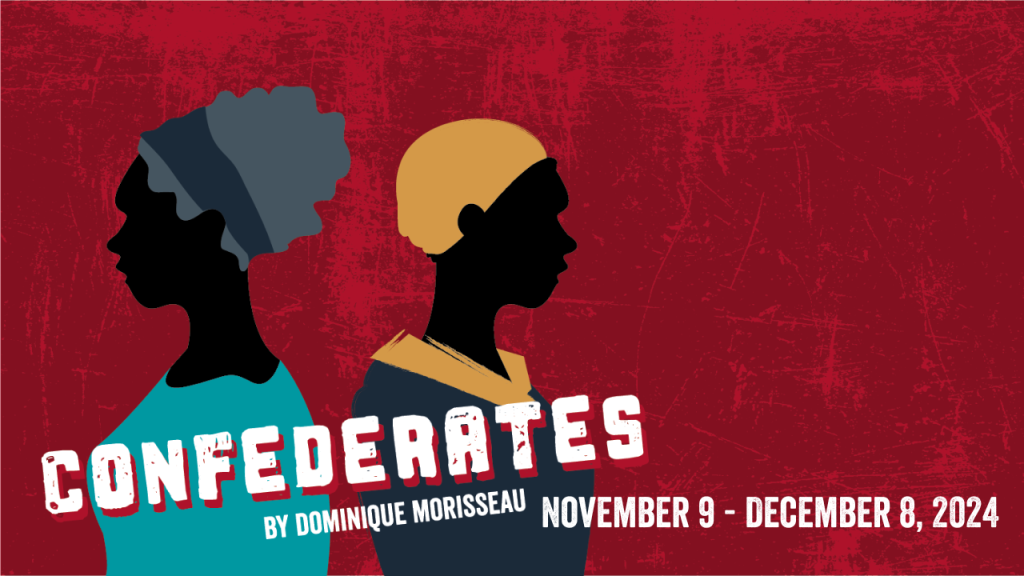- Dominique Morisseau
- Marisa D. Hebert
- November 9 - December 8
- November 7-8
- Buy Now
Regional Premiere
Truthful. Transcendent. Taut.
Brilliant writer, Dominique Morisseau, who wrote Detroit ‘67, Skeleton Crew, and Ain’t too Proud, comes back to the Curious stage with her latest work. Morisseau is a master at weaving together personal, historical, and social narratives, and this show is considered her most ambitious yet. This visionary play explores institutional racism through the dual lenses of Sara, an enslaved rebel turned Union spy, and Sandra, a tenured professor in a modern-day private university. The regional premiere that leaps through time to trace the stories of these two Black American women has been called “luminous,” “engrossing,” and “surprisingly funny.” Confederates will be directed by Marisa D. Hebert.
Find the Digital Playbill Here
CONTENT ADVISORY: Curious offers a public advisory about any stage effect of potential concern to patrons’ health, such as strobe lights, theatrical fog or smoking. This production of CONFEDERATES does NOT have any stage effects of potential concern to patrons’ health.
Curious also offers voluntary advisories about subject matter. If you would like to read the content advisory for CONFEDERATES, click “Details” below.
Details
Details for CONFEDERATES:This production contains strong language, racialized language, and presence of a prop gun. However as sensitivities vary from person to person, if you have any other concerns about content or age appropriateness that might have a bearing on patron comfort, please contact the Box Office at 303.623.0524.
Dates & Times
| Date | Time | Additional Information |
Cast
Production Team
Go Deeper: Confederates
Compiled by Christy Montour-Larson
CONTENTS
- An Interview with Playwright Dominique Morisseau
- Playwright’s Rules of Engagement
- Civil War Timeline
- Important Voices Of Resistance In The Civil War
- Exploring Critical Race Theory Through Confederates
- Black Women in Academia
- Discussion Questions
- Denver Public Library Recommendations
AN INTERVIEW WITH PLAYWRIGHT DOMINIQUE MORISSEAU
Excerpts from Signature Theatre Interview with Andrea Ambam
What inspired this particular play, and how did it come to be?
I like to know where I am in my own freedom story. Where were the examples of me or the
unsung? I thought, “Well If I’m going to look at the past, I can’t look at through a vacuum. I
have to look at the past in relationship to the present.” I don’t want to be distant. I want to be
up-close and personal and overt. I wrote this play to look at the relationship between the past
and present not knowing that eventually that kind of thinking was going to be banned in 15
states in this country.
Do you remember your own education of the Civil War? Was there anything you learned by
writing this show that shocked you, or that you couldn’t believe hadn’t been covered in
school? My knowledge of the Civil War came mostly from school, where you’re taught a very
limited curriculum about the Civil War and the reasons for it. To be someone who writes a lot
about history, I was really bored with it in high school. I definitely don’t remember it as
something that felt personal and alive to me. I knew Sojourner Truth’s name, I knew Harriet
Tubman’s name, but I didn’t know about union spies, and I didn’t understand how we were
architects of our own freedom. I wanted to know the intricate details of that, so that’s why I
started studying that for this [play].
Confederates is radically different than anything I’ve ever written, and it is radical to me in its
DNA. I think there’s always some kind of fear and aversion if a story is going to have something
about slavery. I think people get really, “we’re over it.” All I can say is that we’re aware of that,
and the story is aware of that, so come and know that you’re in some safe hands. I don’t
believe in the inhumanity of the enslaved. I believe the same complex feelings that we have
going on today, they also had going on back then. I believe that the same way we have to
navigate patriarchy or white fragility or class issues, they also had to figure that out and deal
with that and put on a face here and then take it off there. We’re playing with genre to really
be able to humanize the enslaved and also those of us in the present.
Sandra and Sara are two powerful Black women in this show on parallel liberation journeys.
How much of yourself do you see in these women? What does it mean to be a Black woman
writing and telling stories at this time in the American Theatre, and how do you seek your
own internal and external liberation in this industry and beyond? In this play these two Black
women, one who is an enslaved rebel woman trying to get free from literal, physical bondage
and the other who is a Black woman professor at a contemporary university- a predominantly
white institution- is trying to get free mentally. From that mental restriction and that mental
oppression that she’s experiencing. These two Black women feel, because of who they are,
wanting to be free inside of themselves, wanting to live without being underneath a gaze that
suffocates them; they feel that they have a target on their backs and they do they literally have
a target on them.
And I feel that way as a Black woman theatre marker that writes what I write unapologetically. It
just feels like a looming target on my back and I never know when somebody is going to take
fire. I feel like I have it on me all the time. And “ I’m sure I’m not the only one who feels that
way. I think we are in the time where we are burning books, banning books in states, banning
ideas. I definitely feel unsafe. And I also feel unwilling to cower to that feeling. I feel vulnerable
and unsafe and courageous because I’m gonna keep going. Obviously, we all have to keep
telling the stories that we are moved to tell, but telling them at this time feels particularly
Dangerous.
Why is calling in the ancestors important to the process of Confederates? There are some
bold, courageous things that have to happen in this play, and to know that you’re doing that in
partnership with your ancestors, that they’re there with you, and the ancestors that went
through some of the things that we’re gonna enact in this play – not necessarily traumatic
things, but boldness – that you’re not doing those things in a vacuum; you’re doing those things
with the ancestors present.
PLAYWRIGHT’S RULES OF ENGAGEMENT
By Dominique Morisseau
You are allowed to laugh audibly.
You are allowed to have audible moments of reaction and response.
My work requires a few “um hmms” and “uhn uhnns” should you need to use them. Just
maybe in moderation. Only when you really need to vocalize.
This can be church for some of us, and testifying is allowed.
This is also live theatre and the actors need you to engage with them, not distract them
or thwart their performance.
Please be an audience member that joins with others and allows a bit of breathing
room. Exhale together. Laugh together. Say “amen” should you need to.
This is community. Let’s go.
CIVIL WAR TIMELINE
1860
November 6: Abraham Lincoln, a known opponent to slavery, is elected President.
1861
January: South Carolina, Florida, Mississippi, Alabama, Georgia, Louisiana and Texas are the
first states to secede from the Union and form the Confederate States of America. They’re later
joined by Virginia, Arkansas, Tennessee and North Carolina.
April 12: The first shots of the Civil War are fired at Fort Sumter at the entrance to the harbor of
Charleston, South Carolina
Battle of Fort Sumter
July – The South sustains a victory at the First Battle of Bull Run at Manassas Junction, Virginia.
1862
January 27: President Lincoln issued General War Order No. 1, ordering all Union soldiers to
advance on the Confederacy.
September 17 Confederate and Union forces fight at Antietam, the bloodiest day of the Civil
War.
Battle of Antietam
September 22: President Lincoln issued the Emancipation Proclamation, declaring all enslaved
People in rebel territory were free as of January 1st, 1863. The proclamation did not, however, free
all enslaved people, and honored slavery in slave-holding states that had remained loyal to the
Union.
1863
January: The First South Carolina Volunteer Infantry Regiment, composed of Black soldiers and
authorized by President Lincoln, organized in South Carolina to fight for the Union. Harriet
Tubman served as a cook and nurse, and eventually as a spy and scout with the regiment.
The 1st South listened to the reading of the Emancipation Proclamation on January 1, 1863.
May Union General Grant captures Port Hudson, Louisiana during the Vicksburg Campaign,
gaining control of the Mississippi River and splitting the Confederacy in two
July 1 – 3: In the Battle of Gettysburg, Union forces fend of Confederate soldiers and halt their
invasion of the North. Following the battle Lincoln delivered the famous “Gettysburg Address.”
June 15: Congress rules that Black soldiers must receive equal pay.
107th U.S. Colored Infantry Fort Corcoran near Washington, D.C.
September – After months of battles, the Confederacy surrenders Atlanta to the Union.
1864
April 9: Confederate General Robert E. Lee and Union General Ulysses S. Grant meet at
Appomattox Courthouse and agree on terms of a Confederate surrender.
The surrender of General Lee to General Grant at Appomattox Court House
April 14: President Lincoln is assassinated by actor John Wilkes Booth during a performance of
Our American Cousin at Ford’s Theater in Washington D.C.
June 19: Two and half years after the Emancipation Proclamation was signed, federal troops
arrived in Galveston, Texas (where slavery largely persisted) to take control of the state and
ensure that all enslaved people were freed. “Juneteenth” honors the end to slavery in the
United States and is considered the longest-running Black holiday. Juneteenth became a federal
holiday in 2021.
Woman in a decorated carriage on Juneteenth, in Houston’;s Fourth Ward, ca. 1900
IMPORTANT VOICES OF RESISTANCE IN THE CIVIL WAR
Many brave Black American men and women risked their lives to learn and share intelligence
vital to the success of the Union, playing an important role in the outcome of the Civil War.
Slaves and freed African Americans were an invaluable resource to the Union, providing
information on the Confederate forces. They became known as the “black dispatches.”
Mary Elizabeth Bowser
A formerly enslaved woman, Bowser infiltrated the Confederates White House as servant,
providing crucial information to Union forces by eavesdropping on conversations. She gained
access to lists of troop movements, Union prisoner locations and military strategy and treasury
reports.
Abraham Galloway
A prominent Black Union spy who provided critical information about Confederate coastal
defenses and helped recruit African American soldiers. One of the first African Americans
elected to the North Carolina Senate.
Mary Louvestre
Mary Louvestre was a free Black woman living in Norfolk, VA, where a Confederate ship was
being built in a port across the river where she worked as a housekeeper in Norfolk for one of
the engineers. Facing certain death as a spy if caught, she treks two hundred miles during the
bitter winter of 1862 to reach the office of Union Secretary of the Navy Gideon Welles, where
she hands over the plans.
Harriet Tubman
While well-known for her work on the Underground Railroad, Tubman also played a significant
role in gathering intelligence for the Union army, utilizing her knowledge of the South to
infiltrate Confederate territory.
EXPLORING CRITICAL RACE THEORY THROUGH CONFEDERATES
Critical Race Theory (CRT) is an academic framework developed in the 1970s and 1980s by legal
scholars like Derrick Bell, Kimberlé Crenshaw, and Richard Delgado. Its purpose is to examine
how racial inequality is embedded in legal systems, policies, and institutions rather than solely in individual prejudices.
“Confederates” invites audiences to reflect on the structural and systemic nature of
racism, the intersectionality of identities, and the ongoing impact of historical injustices in shaping contemporary society
Historical Context and Structural Racism
CRT emphasizes that racial inequality is embedded in the legal and social systems rather
than being merely a product of individual prejudice Confederates examines the
historical context of slavery and its enduring impact on African American lives today,
reflecting how systemic racism shapes the characters’ experiences.
Intersectionality
The concept of intersectionality, introduced by Kimberlé Crenshaw, is central to CRT and
highlights how different forms of oppression overlap. In Confederates, characters
navigate multiple identities—race, gender, class—showing how these intersect to create
unique experiences of oppression and resilience.
Interest Convergence
Derrick Bell’s principle of interest convergence suggests that progress for racial justice
occurs only when it aligns with the interests of those in power. The play examines
moments of compromise and negotiation regarding race, showcasing how true progress
is often contingent on broader societal interests.
Legacy of Racism
CRT argues that the legacy of racism continues to influence contemporary societal
structures. Confederates delves into how the past informs the present, illustrating
how historical injustices continue to affect the lives of the characters and their
Communities.
Critique of American Identity
The play challenges conventional narratives of American identity, paralleling CRT’s
critique of how history is taught and understood. It confronts the notion of a unified national identity by addressing the painful truths of America’s past regarding race and
Equality.
Dialogue and Understanding
CRT advocates for dialogue around race and racism to foster understanding and healing.
Confederates uses dialogue among its characters to explore complex issues of race
and identity, encouraging audiences to engage with these difficult conversations.
Sources:
Derrick Bell: Faces at the Bottom of the Well: The Permanence of Racism (1992)
Kimberlé Crenshaw : Mapping the Margins: Intersectionality, Identity Politics, and
Violence Against Women of Color (1991)
Richard DeAngelo: Critical Race Theory: An Introduction (2017)
New York Times: What Is Critical Race Theory, and Why Is It Under Attack?
Published on July 14, 2021
BLACK WOMEN IN ACADEMIA
Black women in academia have made significant strides but still face substantial disparities in
representation, advancement, and experience. Here are some key statistics and trends related to Black women in higher education:
Faculty Representation
Tenure-Track and Tenured Positions: Black women hold only about 2% of tenure-track
and tenured faculty positions, with Black faculty (all genders) making up about 6% of
faculty nationwide. In contrast, white faculty make up approximately 75% of tenured
and tenure-track positions, with higher representation in prestigious institutions.
Full Professorships: Black women are even rarer at the full professor level, making up
only about 1% of full professors nationwide. White men and women, in comparison,
hold about 85% of full professor positions, with white men significantly outnumbering
white women.
Adjunct and Non-Tenured Roles: Many Black women in academia are employed in
adjunct or non-tenure-track positions, which often come with lower pay, fewer benefits,
and less job security compared to tenured positions.
Experiences in Academia
Discrimination and Bias: Studies indicate that Black women faculty face frequent
instances of discrimination and bias. They often report experiences of racial and gender
discrimination, including feeling marginalized or undervalued compared to their white
Colleagues.
Service Burden: Black women in academia are more likely to be asked to serve on
diversity-related committees or participate in “invisible labor,” such as mentoring
students of color, which can take time away from research and publishing, both critical
for tenure.
Pay Disparities: Black women in academia generally earn less than both their male
counterparts and women of other racial backgrounds, with Black female professors
earning, on average, 84 cents for every dollar earned by white male professors.
Leadership Roles
Administrative Positions: Black women remain underrepresented in academic
leadership, holding fewer roles as deans, provosts, or college presidents. As of recent
data, only about 5% of college presidents are Black, and an even smaller percentage are
Black women.
Pipeline to Leadership: The lack of Black women in senior roles is often attributed to
systemic barriers in the tenure track, limited access to mentorship, and fewer
networking opportunities compared to their white peers.
Sources:
National Center for Education Statistics
The American Council on Education
The Chronicle of Higher Education
The Association of American Colleges & Universities
DISCUSSION QUESTIONS
- What is the meaning of the play’s title, Confederates? Who are the confederates in the
two stories?
- The first thing we see in Confederates is a century-old photograph of a breastfeeding
woman. How did it make you feel? Did your feelings of the photograph change by the
end of the play? Why or Why not?
- Compare and contrast the journeys of Sandra and of Sara. In what ways are the two
women similar? In what ways are they different?
- The characters of Abner and Malik are played by the same actor. In what ways does this
double casting give information about both characters? What wars are they both
fighting?
- In what ways does female infertility or “being barren” impact Sara, Missy Sue, and
Sandra in the play? In what ways is it disempowering and for which characters? In what
ways is it empowering and for which characters?
- What kind of power does Missy Sue have over Sara? What power does Sara have over
Missy Sue?
- The characters of LuAnne and Jade are played by the same actor. Compare and contrast
their journeys in the play. In what ways does this double casting give information about
both characters?
- Why does the playwright juxtapose slavery with academia in this play? How are they
similar? In what ways are they different? What is learned from experiencing the two
worlds side by side? What parallels, if any, can be drawn?
- Malik’s paper is about the links between what he calls the “modern-day plantation” of
corporate America and the antebellum South. Where do you see the links? What is
different?
- What are the different freedoms desired in the play? What sets Sandra free? Sara?
- Malik/Abner is the only male presenting character in the play. What do you think those
two characters, and the role of masculinity/male privilege play in this piece?
- How did you feel the set, lights, costumes and sound added to your experience of the
play?





